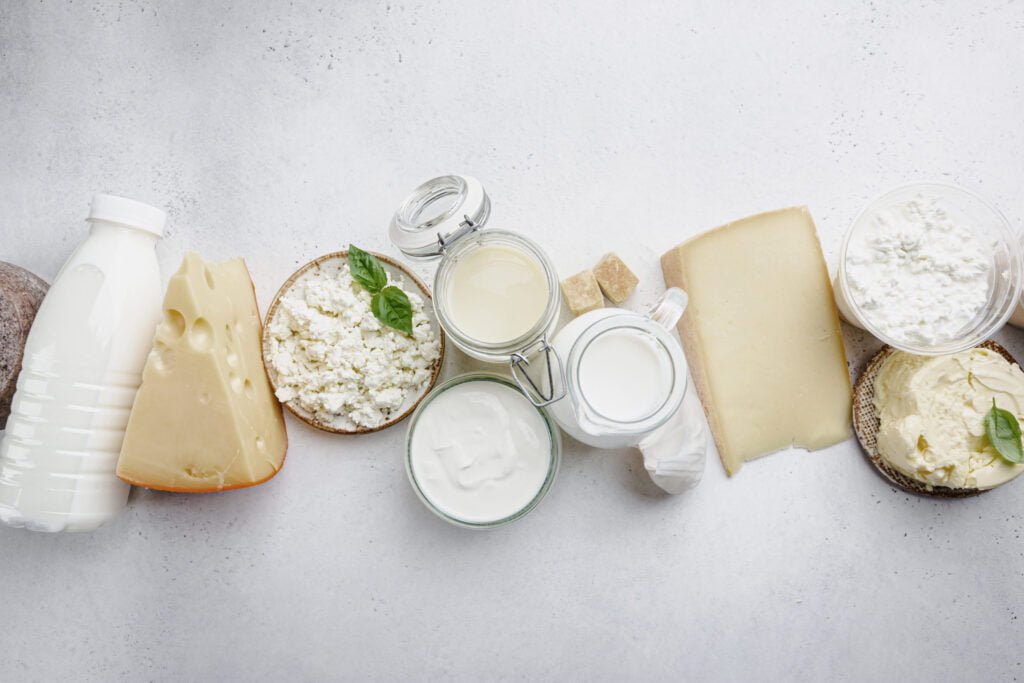The preparation of common dairy products such as Dahi, Cheena, Khoa, Paneer, and ice cream involves distinct processes that highlight the versatility of milk. These dairy products form an essential part of traditional cuisines and offer unique flavors, textures, and nutritional benefits. Here’s how these popular dairy products are made:
Table of Contents
Common Dairy Products
1. Dahi (Curd)
Dahi is one of the simplest fermented dairy products widely consumed in many parts of the world, particularly in South Asia. It is prepared by fermenting milk using bacterial cultures.
To make Dahi:
- First, milk is boiled and then cooled to around 40°C to create the right environment for bacterial growth.
- A small quantity of pre-existing Dahi (starter culture) is mixed into the warm milk. The bacteria in the starter culture, mainly lactic acid bacteria, ferment the lactose in milk into lactic acid.
- The acidification process leads to the coagulation of milk proteins, creating the smooth and thick consistency typical of Dahi.
- After setting the milk at room temperature for 6-8 hours, the Dahi is ready. This transformation of milk into Dahi is a classic example of how fermentation plays a crucial role in the production of dairy products.
2. Cheena (Chhena)
Cheena, another versatile dairy product, is essentially the base for many Indian sweets like Rasgulla and Sandesh. It is a fresh, soft cheese made by curdling milk with an acidic agent.
To make Cheena:
- Begin by bringing full-fat milk to a boil. Once the milk reaches boiling point, add a mild acid such as lemon juice or vinegar, which will cause the milk to curdle.
- The curds (solid part) separate from the whey (liquid part). The curds are collected in a muslin cloth and rinsed with water to remove any residual acidity.
- The muslin cloth is then tied and hung to allow the whey to drain out. After about an hour, the resulting soft and crumbly Cheena can be used in a variety of dairy products and dishes.

3. Khoa (Khoya)
Khoa is one of the richest dairy products, used as a base ingredient in many Indian sweets such as Gulab Jamun and Barfi. It is made by slowly evaporating the water content in milk, leaving behind a dense, solid mass.
To prepare Khoa:
- Full-fat milk is poured into a heavy-bottomed pan and simmered over medium heat. The milk is stirred constantly to prevent it from sticking to the pan as it thickens.
- Over time, most of the moisture evaporates, and the milk begins to solidify into a thick mass.
- Once the milk reduces completely and forms a dense consistency, Khoa is ready. This concentrated dairy product can be stored for later use or combined with sugar to make sweets.
4. Paneer
Paneer, a popular fresh cheese, is a staple in South Asian cuisine and can be used in both savory and sweet dishes. Like other dairy products, Paneer is made by curdling milk, but it requires pressing for a firmer texture.
To make Paneer:
- Boil the milk and add an acidic agent, such as lemon juice or vinegar, to curdle the milk.
- The curds are separated from the whey and gathered in a muslin cloth.
- After rinsing, the cloth is pressed under a heavy object to remove excess moisture and to form a firm block of Paneer.
- The resulting Paneer can be sliced into cubes or used in dishes like Paneer Butter Masala and Palak Paneer, making it one of the most versatile dairy products.
5. Ice Cream
Ice cream is a beloved frozen dairy product, made by combining milk, cream, sugar, and flavorings. Unlike other dairy products, ice cream also requires freezing and churning to incorporate air and achieve its signature light texture.
To prepare ice cream:
- Heat milk, cream, and sugar in a saucepan until the sugar dissolves.
- For richer flavors, a custard base made with egg yolks is sometimes used, where the egg yolks are tempered with the hot milk mixture and then heated until slightly thickened.
- After cooling the mixture, it is poured into an ice cream maker and churned to incorporate air, resulting in a smooth texture.
- Once churned, the ice cream is frozen for a few hours before serving. Ice cream is one of the most popular dairy products worldwide and can be made in endless flavors, from classic vanilla to exotic fruits.
Dairy products are foods derived primarily from the milk of mammals, predominantly cows, buffalo, goats, and sheep. These products play a significant role in human diets across the world, providing essential nutrients such as calcium, protein, vitamins, and fats. The variety and versatility of dairy products make them a vital part of both traditional and modern culinary practices. Below, we will explore different types of dairy products, their nutritional benefits, and their significance in both nutrition and culture.
In conclusion, each of these dairy products—Dahi, Cheena, Khoa, Paneer, and ice cream—requires different preparation methods, but they all start with milk. The transformation of milk into a variety of dairy products demonstrates the versatility and importance of this staple ingredient. Whether through fermentation, coagulation, or freezing, these processes ensure that dairy products remain an essential part of global diets.
Frequently Asked Questions (FAQs)
How are dairy products prepared?
Pasteurised milk is cooked to 161°F for 15 seconds, whereas ultrapasteurized milk is heated to 280°F for two seconds. It is then immediately chilled to guarantee that its freshness remains.
What are the main products of dairy?
These include milk-based goods like cheese, yoghurt, kefir, ice cream, and butter.
Related Articles

